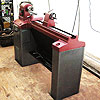I was wondering if any body has cut veneer on any of the saw guide systems festool, EZ guide. (One sheet at a time not a bundled sandwiched between two boards) and what your results were as fare as edge quality and being able to just assemble the pieces direct with out having to sand or touch up the edges? I have been looking at some how to videos of veneer work as of late and was thinking this may work fairly well, do to the fact the anti-chip strip on the guides holds down the work piece (veneer) and gives you a chip free edge in standard applications, has anybody tried this?




 Reply With Quote
Reply With Quote





